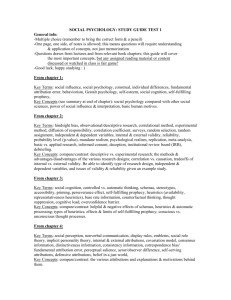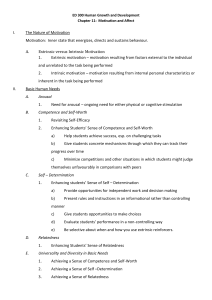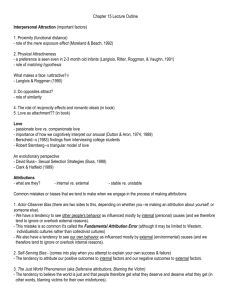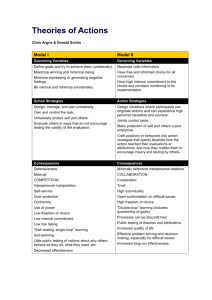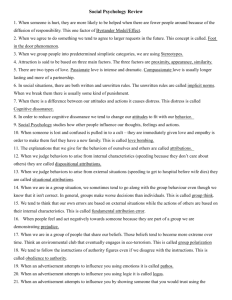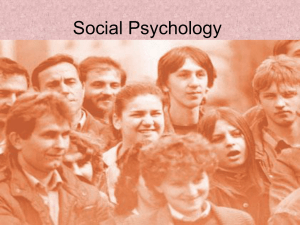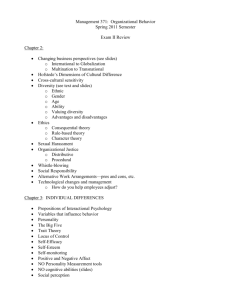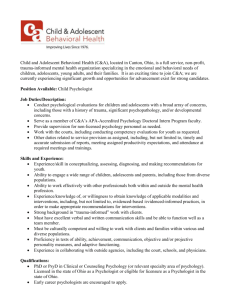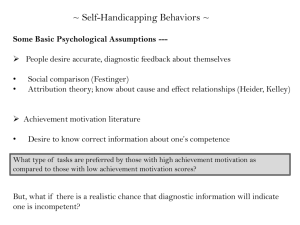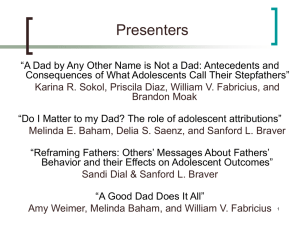CHAPTER 12:
advertisement
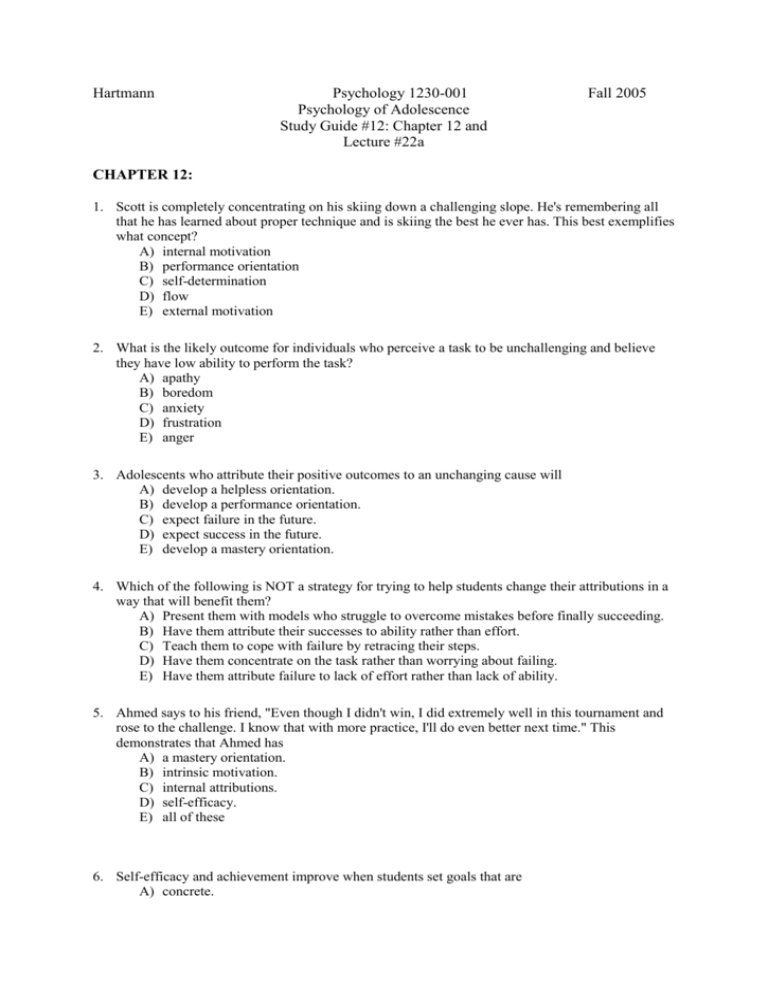
Hartmann Psychology 1230-001 Psychology of Adolescence Study Guide #12: Chapter 12 and Lecture #22a Fall 2005 CHAPTER 12: 1. Scott is completely concentrating on his skiing down a challenging slope. He's remembering all that he has learned about proper technique and is skiing the best he ever has. This best exemplifies what concept? A) internal motivation B) performance orientation C) self-determination D) flow E) external motivation 2. What is the likely outcome for individuals who perceive a task to be unchallenging and believe they have low ability to perform the task? A) apathy B) boredom C) anxiety D) frustration E) anger 3. Adolescents who attribute their positive outcomes to an unchanging cause will A) develop a helpless orientation. B) develop a performance orientation. C) expect failure in the future. D) expect success in the future. E) develop a mastery orientation. 4. Which of the following is NOT a strategy for trying to help students change their attributions in a way that will benefit them? A) Present them with models who struggle to overcome mistakes before finally succeeding. B) Have them attribute their successes to ability rather than effort. C) Teach them to cope with failure by retracing their steps. D) Have them concentrate on the task rather than worrying about failing. E) Have them attribute failure to lack of effort rather than lack of ability. 5. Ahmed says to his friend, "Even though I didn't win, I did extremely well in this tournament and rose to the challenge. I know that with more practice, I'll do even better next time." This demonstrates that Ahmed has A) a mastery orientation. B) intrinsic motivation. C) internal attributions. D) self-efficacy. E) all of these 6. Self-efficacy and achievement improve when students set goals that are A) concrete. Psychology 1230-001 (Hartmann) Study Guide #12, Fall, ’05, p. 2 of 6 B) C) D) E) proximal. specific. challenging. all of these 7. Which of the following is TRUE about self-regulatory learners? A) They are often high achievers. B) They monitor how well they are sticking to their plan. C) They make judgments about how well they are doing at a task. D) They evaluate what they did in order to see what needs to be done in the future. E) all of these 8. Which of the following statements is TRUE? A) Mothers' achievement expectations for their first graders are related to the children's academic achievement when they reach age 23. B) Parental expectations relate to children's achievement much less that teachers' expectations do. C) High parental expectations for achievement positively correlate with children's anxiety and poor performance. D) Parental expectations for children's academic success do not predict children's performance. E) Parents' expectations for their children's success are related to the gender of the child's teacher. 9. Dashonna is from a middle-SES African American family. When Dashonna doesn't do well in her gymnastics competition, she is likely to attribute her poor performance to A) racial discrimination. B) not enough effort. C) bad luck. D) gender bias. E) lack of ability. 10. How do American parents' standards and expectations compare with Asian parents' in regard to their children's math achievement? A) American parents' achievement standards are higher than those of Asian parents. B) American parents help their children with their homework more than Asian parents do. C) American parents view their children's math achievement as more due to innate ability, whereas Asian parents believe their children's achievement is more due to effort. D) American parents are not satisfied with their children's achievement and education, whereas Asian parents are. E) American parents view their children's achievement as due to training, whereas Asian parents believe it is innate. 11. What is the difference between attributions and self-handicapping strategies? A) Attributions have to do with success and self-handicapping strategies have to do with Psychology 1230-001 (Hartmann) Study Guide #12, Fall, ’05, p. 3 of 6 failure. B) Attributions occur after performance and self-handicapping strategies occur before performance. C) Attributions are not completely under the control of the individual, but self-handicapping strategies are. D) Attributions are cognitive, but self-handicapping strategies are emotional. E) all of these 12. In the United States, what percent of high school students works at a job during the school week? A) 20 percent B) 40 percent C) 55 percent D) 75 percent E) 95 percent 13. The typical part-time job for a high school senior in the United States involves A) 30 or more hours per week. B) 16 to 20 hours per week. C) 9 to 12 hours per week. D) 6 to 10 hours per week. E) 3 to 5 hours per week. 14. Which of the following myths about adolescent work experience did Greenberger and Steinberg's research disprove? A) Adolescents are lazier on the job than are adults. B) Adolescents are more dishonest on the job than are adults. C) Adolescents learn to get along with adults by working with them. D) Adolescents give favoritism to friends at work. E) Adolescents become more honest after they have had a job. 15. As the number of hours per week college students work increases, A) the more likely they are to drop out of college. B) the more their grades suffer. C) the more limited their choice of classes. D) the less likely they are to obtain their college degree. E) all of these 16. Joe goes to a large high school where there is a group of other adolescents like him who are taking courses having to do with business and finance. His friend, Sean, is part of a group of students who are taking courses having to do with science and engineering. Joe never has any classes with Sean. This college-and-career approach is called A) schools-within-schools. B) a single-theme school. C) a technology school. D) majors, clusters, and pathways. E) career-segregated schools. 17. Which of the following is NOT a criticism of Ginzberg's developmental career choice theory? A) Data were collected from middle-SES subjects. Psychology 1230-001 (Hartmann) Study Guide #12, Fall, ’05, p. 4 of 6 B) C) D) E) The time frames are too rigid. The theory does not take into account individual differences. Realistic career choices don't occur until middle adulthood. Data were collected on youth with more career options open to them. 18. Beth has narrowed her career options to a therapist or lawyer and now is seeking additional education that will help her to eventually enter one of those professions. She is in Super's career self-concept phase of A) consolidation. B) implementation. C) stabilization. D) crystallization. E) specification. 19. A key flaw in Holland's personality type theory of career choice is that A) lower-SES adolescents have few career interests. B) career opportunities are always changing. C) personality has little to do with career choice. D) most individuals aren't just one personality type. E) ethnic differences have not been assessed. 20. Csikszentmihalyi and Schneider studied the attitudes of adolescents and found that students who perceived school to be more playlike than worklike A) had the lowest future expectations. B) had the highest future expectations. C) had the lowest performance orientation. D) had the highest performance orientation. E) were most likely to drop out of school. 21. To intervene effectively in the career development of ethnic minority youth, counselors need to A) discuss with youth how some cultural values may be in conflict with the values of the occupational world. B) understand the importance of family to many ethnic minority groups. C) be more knowledgeable about different communication styles. D) take into account different achievement expectations in ethnic minority groups. E) all of these Discussion Questions: 1. Explain why adolescence is a critical juncture in achievement. Indicate circumstances and experiences than can promote or inhibit a commitment to achievement at this time in life. 2. List three groups of hard-to-motivate students likely to be identified in high school classed and describe characteristic patterns of behavior they demonstrate. Lectures #22a 1. One of the consequences of our interest in attributions is that we have discovered that teachers A. strangely, don’t make attributions about success and failure B. make attributions about girls but not about boys C. attribute girls failure to ability and boys to effort D. attribute much of adolescent behavior to drugs and sex Psychology 1230-001 (Hartmann) Study Guide #12, Fall, ’05, p. 5 of 6 E. none of the above Psychology 1230-001 (Hartmann) Study Guide #12, Fall, ’05, p. 6 of 6 2. The study by Wilson & Linville on the effects of attributions on behavior demonstrated that A. Guys who score really do score B. The stuff about attributions is largely bunk C. Girls and boys have similar attributions about freshman performance D. Attributions about the instability of grades resulted in improvements in grades E. None of the above 3. The following components are perhaps most relevant to a program that is aimed at kids _____________________: Provide support by individualizing instructions and related materials. Conduct a careful task analysis and provide instructional goals consistent with the kid’s capacity. Also, emphasize the importance of effort for producing good outcomes. A. with low ability who have developed low achievement expectations B. with failure syndrome C. obsessed with protecting their self-worth by avoiding failure D. who are unusually tall and can’t dance E. none of the above 4. The following components are perhaps most relevant to a program that is aimed at kids _____________________: Give them challenging tasks that are within their area of competence; gradually increase the level of challenge. Strengthen association between effort & self-worth. Set up situations so everyone can be a winner A. with low ability who have developed low achievement expectations B. with failure syndrome C. obsessed with protecting their self-worth by avoiding failure D. who are unusually tall and can’t dance E. none of the above 5. Which of the following is NOT a retraining procedure recommended for youth who have failure syndrome? A. Elliptical training B. Efficacy training C. Attribution training D. Strategy training E. More than one of the above are NOT recommended.
